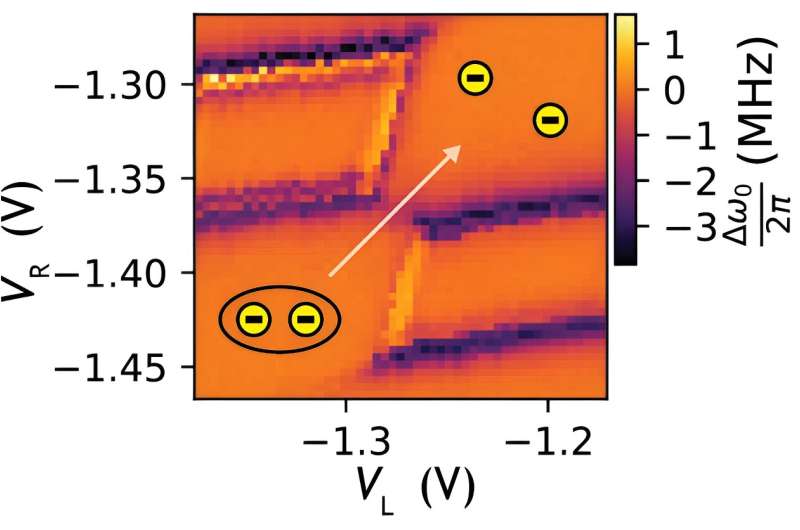Cooper pairs are pairs of electrons in superconducting materials that are bound to each other at low temperatures. These electron pairs are at the root of superconductivity, a state where materials have zero resistance at low temperatures due to quantum effects. As quantum systems that can be relatively large and easy to manipulate, superconductors are highly useful for the development of quantum computers and other advanced technologies.
Researchers at Delft University of Technology (TU Delft) recently demonstrated the controllable splitting of a Copper pair into its two constituent electrons within a hybrid quantum dot system, holding onto them after the split. Their paper, published in Physical Review Letters, could open new avenues for the study of superconductivity and entanglement in quantum dot systems.
“This research was motivated by the fact that Cooper pairs, the fundamental ingredients of superconductivity that carry electrical current with no resistance, are formed by pairs of electrons that are expected to be perfectly quantum entangled,” Christian Prosko, one of the authors of the paper, told Phys.org.
“Previous work by numerous research groups has gone into splitting Cooper pairs into their two constituent electrons to check for this entanglement, but we hoped to build on these experiments by fabricating a device in which one could ‘hold on’ to two electrons after splitting a pair to investigate their properties further.”
While researchers have identified multiple ways to check if two particles are quantum entangled, retaining the particles after they are split can greatly advance these efforts. Leo P. Kouwenhoven’s lab at TU Delft specializes in techniques that exploit microwave resonators to probe the movement of electrons, enabling the control of electrons in devices without having to pass electrical currents through them.
“In our case, we hold on to them by ensuring they are stuck in quantum dots, regions of a semiconducting material designed to behave like a box for holding electrons,” Prosko said.
“At the same time, we wanted to demonstrate a method for actually detecting the moment when a Cooper pair is split, so we designed a detector out of quantum dots which can sense when an individual electron jumps on or off of it. I should note here that around the time of this work, another group observed the splitting of single Cooper pairs.”

Conventional devices to split electrons bound in Cooper pairs consist of a superconductor-based electrical contact and two ordinary metallic contacts, separated by quantum dots. Quantum dots typically only receive one electron at a time, while electrical current flowing through semiconductors is carried by electron Cooper pairs.
“If you force a current between the superconductor and the metal contacts, Cooper pairs have no choice but to split in order to make it through the quantum dots towards the other metal terminals of your circuit,” Prosko explained. “In our case, we replaced the superconducting lead with an isolated chunk of superconductor and got rid of the electrical contacts entirely. By applying electric fields to the quantum dots and superconductor, we were able to ‘push’ a single Cooper pair out of the superconductor, forcing it to split onto the two quantum dots.”
Due to its unique design and the absence of electrical contacts, the hybrid quantum dot system created by Prosko and his colleagues has no electrical current flowing through it. When they ‘pushed’ a single Cooper pair out of the superconductor, the electrons became isolated onto the quantum dots. Through this process, the researchers were able to hold on to split electrons that were previously part of a single Cooper pair.
“Our recent work consisted of two parts: Splitting a single Cooper pair and holding on to the resulting electrons, and separately demonstrating a method for detecting single electrons jumping on to a quantum dot without external charge sensors,” Prosko said. “These two achievements together would allow one to cause Cooper pair splitting events and detect the emerging electrons in real time, moving us one step closer to testing the quantum entanglement of electrons which is so fundamental to superconductivity.”
Some of the authors of this paper have now completed their Ph.D. at TU Delft and started working at other institutes and companies. In the future, these researchers and other students who are still part Kouwenhoven’s lab will continue exploring superconductivity, quantum entanglement, and quantum computing.
“We hope our research groups will continue combining the single Cooper pair splitting technique with parity sensors that can also detect the magnetic spin of electrons,” Prosko added.
“This would allow for a test of Bell’s inequality, where we could verify that electrons in superconductors really are quantum entangled. Similar tests have been carried out on electrons in semiconducting qubits. On another note, our research group has been very interested in Cooper pair splitters recently as a way to build especially robust qubits out of exotic so-called ‘Majorana bound states’, and these qubits might be more effective by using our approach of getting rid of some of the lead contacts.”
More information:
Damaz de Jong et al, Controllable Single Cooper Pair Splitting in Hybrid Quantum Dot Systems, Physical Review Letters (2023). DOI: 10.1103/PhysRevLett.131.157001.
© 2023 Science X Network
Citation:
The controllable splitting of a single Cooper pair in a hybrid quantum dot system (2023, November 6)
retrieved 6 November 2023
from
This document is subject to copyright. Apart from any fair dealing for the purpose of private study or research, no
part may be reproduced without the written permission. The content is provided for information purposes only.

